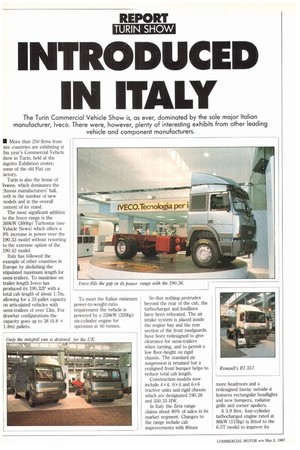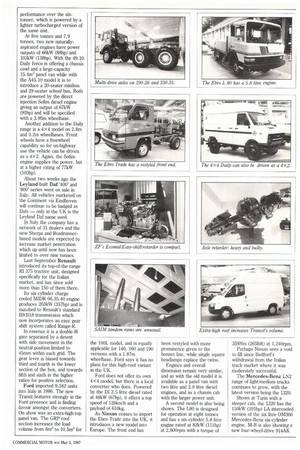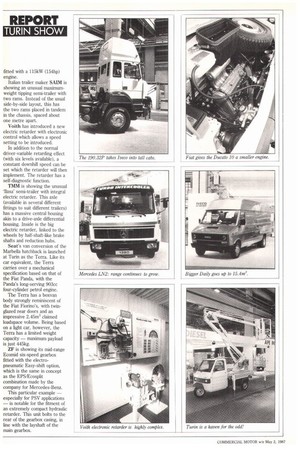INTRODUCED IN ITALY
Page 44

Page 45

Page 46

If you've noticed an error in this article please click here to report it so we can fix it.
The Turin Commercial Vehicle Show is, as ever, dominated by the sole major Italian manufacturer, Iveco. There were, however, plenty of interesting exhibits from other leading vehicle and component manufacturers.
IN More than 250 firms from line countries are exhibiting at his year's Commercial Vehicle thow in Turin, held at the ingotto Exhibition centre; lome of the old Fiat car :actory.
Turin is also the home of Iveco, which dominates the zhassis manufacturers' hall, ooth in the number of new models and in the overall content of its stand.
The most significant addition to the Iveco range is the 269kW (360hp) Turbostar (see Vehicle News) which offers a 9% increase in power over the 190.33 model without resorting to the extreme option of the 190.42 model.
Italy has followed the example of other countries in Europe by abolishing the stipulated maximum length for semi-trailers. To maximise on trailer length Iveco has produced its 190.32P with a total cab length of about 1.7m, allowing for a 33-pallet capacity on articulated vehicles with semi-trailers of over 13m. For drawbar configurations the capacity goes up to 38 (0.8 x 1.8m) pallets. To meet the Italian minimum power-to-weight-ratio requirement the vehicle is powered by a 239kW (320hp) six-cylinder engine for operation at 40 tonnes. So that nothing protrudes beyond the rear of the cab, the turbocharger and feedlines have been relocated. The air intake system is placed inside the engine bay and the rear section of the front mudguards have been redesigned to give clearance for semi-trailers when turning, and to permit a low floor-height on rigid chassis. The standard air suspension is retained but a realigned front bumper helps to reduce total cab length.
Construction models now include 4x4, 6x4 and 6x6 tractive units and rigid chassis which are designated 190.26 and 350.35 HW.
In Italy the Zeta range claims about 80% of sales in its market segment. Changes to the range include cab improvements with 80rtun more headroom and a redesigned fascia; outside it features rectangular headlights and new bumpers, radiator grille and corner spoilers.
A 3.9 litre, four-cylinder turbocharged engine rated at 86kW (115hp) is fitted to the 6.5T model to improve its performance over the sixtonner, which is powered by a lighter turbocharged version of the same unit.
At five tonnes and 7.9 tonnes, two new naturallyaspirated engines have power outputs of 66kW (88hp) and 103kW (138hp). With the 49.10 Daily Iveco is offering a chassis cowl and a large-capacity 15.4m3 panel van while with the A45.10 model it is to introduce a 20-seater minibus and 29-seater school bus. Both are powered by the direct injection Sofim diesel engine giving an output of 67kW (92hp) and will be specified with a 3.95m wheelbase.
Another addition to the Daily range is a 4x4 model on 2.8m and 3.2m wheelbases. Front wheels have a freewheel capability so for on-highway use the vehicle can be driven as a 4x 2. Again, the Sofim engine supplies the power, but at a higher rating of 77kW (103hp).
About two weeks ago the Leyland-built Daf '400' and 800' series went on sale in Italy. All vehicles marketed on the Continent via Eindhoven will continue to be badged as Dafs — only in the UK is the Leyland Daf name used.
In Italy the company has a network of 31 dealers and the new Sherpa and Roadrunnerbased models are expected to increase market penetration which up until now has been limited to over nine tonnes.
Last September Renault introduced its top-of-the-range RI 375 tractive unit, designed specifically for the Italian market, and has since sold more than 150 of them there.
Its six-cylinder charge cooled MIDR 06.35.40 engine produces 263kW (35'7hp) and is matched to Renault's standard B9/B18 transmission which now incorporates an easy gear shift system called Range-R.
In essence it is a double-H gate separated by a detent with side movement in the neutral position limited to 45mm within each grid. The gear lever is biased towards third and fourth in the lower section of the box, and towards fifth and sixth in the higher ratios for positive selection.
Ford imported 9,342 units into Italy in 1986. The new Transit features strongly in the Ford presence and is finding favour amongst the converters. On show was an extra-high-top panel van. The GRP roof section increases the load volume from 8m3 to 10.5m3 for
the 100L model, and is equally applicable for 140, 160 and 190 versions with a 1.87m wheelbase. Ford says it has no plans for this high-roof variant in the UK.
Ford does not offer its own 4x4 model, but there is a local converter who does. Powered by the DI 2.5 litre diesel rated at 48kW (67hp), it offers a top speed of 126km/h and a payload of 610kg.
As Nissan ceases to import the Ebro Trade into the UK, it introduces a new model into Europe. The front end has
been restyled with more prominence given to the bonnet line, while single square headlamps replace the twins.
Engines and overall dimension remain very similar, and as with the old model it is available as a panel van with two litre and 2.8 litre diesel engines, and as a chassis cab with the larger power unit.
A second model is also being shown. The 180 is designed for operation at eight tonnes and has a six-cylinder 5.8 litre engine rated at 82kW (111hp) at 2,800rpm with a torque of 359Nm (2651bft) at 1,240rpm.
Perhaps Nissan sees a void to fill since Bedford's withdrawal from the Italian truck market where it was moderately successful.
The Mercedes-Benz LN2 range of light/medium trucks continues to grow, with the latest version being the 1320.
Shown at Turin with a sleeper cab, the 1320 has the 150kW (201hp) LA intercooled version of the six litre 0M366 Mercedes-Benz six-cylinder engine. M-B is also showing a new four-wheel-drive 914AK fitted with a 115kW (154hp) engine.
Italian trailer maker SAIM is showing an unusual maximumweight tipping semi-trailer with two rams. Instead of the usual side-by-side layout, this has the two rams placed in tandem in the chassis, spaced about one metre apart.
Voith has introduced a new electric retarder with electronic control which allows a speed setting to be introduced.
In addition to the normal driver-variable retarding effect (with six levels available), a constant downhill speed can be set which the retarder will then implement. The retarder has a self-diagnostic function.
TMM is showing the unusual Masa' semi-trailer with integral electric retarder. This axle (available in several different fittings to suit different trailers) has a massive central housing akin to a drive-axle differential housing. Inside is the big electric retarder, linked to the wheels by half-shaft-like brake shafts and reduction hubs.
Seat's van conversion of the Marbella hatchback is launched at Turin as the Terra. Like its car equivalent, the Terra carries over a mechanical specification based on that of the Fiat Panda, with the Panda's long-serving 903cc four-cylinder petrol engine.
The Terra has a boxvan body strongly reminiscent of the Fiat Fiorino's, with twinglazed rear doors and an impressive 2.45m3 claimed loadspace volume. Being based on a light car, however, the Terra has a limited weight capacity — maximum payload is just 445kg.
ZF is showing its mid-range Ecomid six-speed gearbox fitted with the electropneumatic Easy-shift option, which is the same in concept as the EPS/Ecosplit combination made by the company for Mercedes-Benz.
This particular example — especially for PSV applications — is notable for the fitment of an extremely compact hydraulic retarder. This unit bolts to the rear of the gearbox casing, in line with the layshaft of the main gearbox.




























































































































